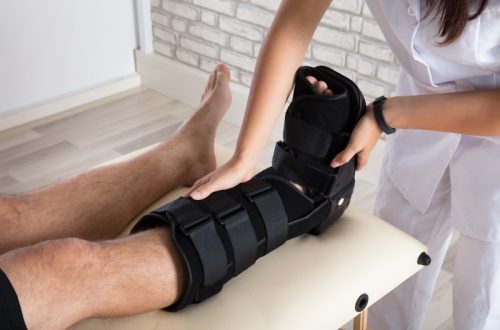Plantar Fasciitis is a condition that is caused by the plantar fascia tissue, that runs along the base of the foot, becoming damaged and imflammed. Many people ask whether the condition will get better without intervention.
So will Plantar Fasciitis go away on its own? Yes, in some cases, plantar fasciitis will go away on its own, provided the planter fascia is given adequate time to rest and heal. This is more likely in the very early stages of plantar fasciitis, when the damage to the plantar fascia is minimal.
There can be consequences to allowing plantar fasciitis to heal on its own such as:
- Increasing pain as time goes on
- Prolonged duration of the condition
- Worstening of the condition instead of healing
- Manifestation of secondary ailments or complications
Continue reading to see why leaving your plantar fasciitis to go away on its own is not always the best choice
Consequences Of Waiting For Your Plantar Fasciitis To Go Away On Its Own
We will now look in greater detail at some of the problems people have encountered when waiting for their plantar fasciitis to heal itself.
Increasing pain
When people first experience the symptoms of plantar fasciitis, it is a very minor discomfort in the base of the foot. Much akin to the same feeling you get when you have a small stone in your shoe. A minor discomfort rather than a pain.
If at this time you were to rest, and refrain from putting weight on your foot for a few weeks, then you may find that the condition rectifies itself.
Unfortunately, not many people are in a postion, or patient enough, to rest for the time it takes to completely heal.
Without taking the adequate recovery time, they will start to act as though they are better and risk further damage to the plantar fascia.
As the damage gets worse, it will start to feel painful when you stand and put weight on the foot. as though you have stood on glass or brass tacks.
Pronlonged Healing Process
With the increased damage to the plantar fascia, the recovery time is also increased.
If you are finding your are now in pain rather than discomfort when you add weight to your foot, then you are likely to be past the point of unaided self healing. As mentioned earlier, it is in the very early stages when resting will allow your plantar fasciitis will go away on its own. If your plantar fasciitis has in fact got worse, it is now unlikely to heal without some kind of intervention on your part such as stretching, orthotic aids, massaging and exercises.
If you do continue to ignore the problem in the hopes it will resolve itself, you will find the pain continuing to increase pain and possible further complications may start to appear.
Further or Secondary Complications
The more damage caused to the plantar fascia, the weaker the tissue becomes and the greater the chance of a major tear or rupture occurring.
Another possible consequence of ignoring the condition is the onset of ankle, knee, hip or back problems.
A common thing for people with foot pain is to compensate their weight onto their healthy foot and walk off balance or with a limp.
Prolonged walking in this way means that more stress is placed onto other areas of the body as they compensate for the altered weight distribution.
This unatural posture and added stress will eventually maifest into pain in other areas of the body that have to work harder to deal with the extra load, most commonly the knees, ankles, hips or back.
Better Choice
As discussed earlier, your plantar fasciitis has the chance to go away on its own if you allow sufficient rest time, but this is not usually possible with todays hectic lifestyles.
To effectively eliminate the condition and prevent it from returning again in the future, it is better to follow some sort of recovery program the moment you are diagnosed with Plantar fasciitis.
You do not have to spend a lot of money on physiotherapy sessions or medical intervention to heal your plantar fasciitis if you are in the early to mid stages of the condition. Following your own stretching recovery program, or one such as the Plantar Fasciitis Plan explained in the excellent book by Colin Dombroski, can be an effective method.
Provided you are dilligent and follow the program to the best of your ability, you should see improvements fairly quickly. You do have to put the work in though if you are to see an improvement. However, if after a few weeks of being consistent in your efforts, you are not seeing any improvement, then you may want to visit your medical practitioner to see if medical options are required.
Conclusion
As with most problems in life, little good comes from ignoring them and hoping they go away by themselves. Plantar fasciitis is no exception.
If you feel that you may be developing the condition, then your best course of action is to do something about it now, whilst the damage is minimal and the chances of a speedy recovery are at their greatest.
Plantar fasciitis can be cured within a matter of weeks with just a few simple changes to your daily routine, and getting to the bottom of the initial cause. Rest, stretching exercises, and suitable supportive footwear are essential to healing, as is time. Recovery times differ in every situation with some people seeing dramatic improvements with a week or two while for others it can be months.
Try to figure out what has caused the plantar fasciitis to develop and make changes to eliminate the cause. Doing this will allow for faster healing and reduce the chances of the problem returning.
Provided you can break the cycle of partial healing and re-injury, as well as implementing a suitable recovery plan, then you stand a very good chance of getting rid of your plantar fasciitis and reduce the chances of it returning again in the future.
A good place to start is by reading our 5 steps to recovery article.








One Comment
Pingback: